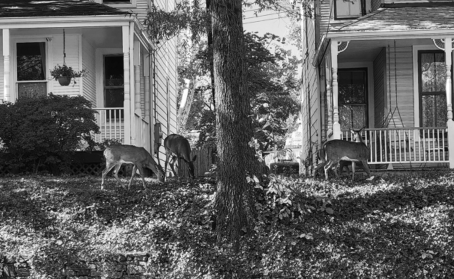Oh, deer! 'Bambi' increasingly unwelcome in US capital

WASHINGTON — To some, they are a magical sight to behold in the heart of the city. To others, it is a pest that eats through their gardens, endangers traffic and helps spread tick-borne diseases.
After nearly being wiped out by rampant deforestation and overhunting in the 19th century, deer have made a stunning comeback across the United States. Estimates place their numbers at more than 30 million, much of it along the East Coast.
In Washington, deer threaten the future of Rock Creek Park, a "hidden jewel" stretching across 710 hectares that offers residents a refuge from daily life in the federal government's seat of power.
"If this forest were perfectly healthy, we wouldn't be able to see this far," National Park Service officer Megan Nortrup told Agence France-Presse.
In the absence of their natural predators, white-tailed deer have devoured native plant species essential to local biodiversity, including the saplings needed for forest renewal.
In other words, woods like these could disappear in the next hundred years or so.
Park botanist Ana Chuquin opens the gate of a small plot fenced to keep deer out. It is part of a long-running experiment involving protected plots paired with unprotected controls.
She points out a 1.8-meter-tall sapling that has survived only because deer were physically prevented from getting to it.
"All around, you don't see one single sapling this size, so it means that we lost that generation," Chuquin said.
Because deer evolved alongside the region's native plants, they prefer to eat them over nonnative invaders like Linden viburnum, a garden favorite whose seeds are carried into the park by wind, water and birds.
That's bad news, because local insect species rely on native plants, and the effects of their loss rise up through food webs, imperiling the wider ecosystem.
Gun-toting biologists
In response to the hoofed menace, the National Park Service decided in 2013 to begin annual culls.
These take place in winter, at night, with the park sealed off. Biologists trained in firearms use infrared heat scanners and night vision goggles as they thin out the herds.
In 2020, the program was extended to other Washington parks managed by the NPS.
At their peak, deer numbered more than 100 per square mile — far more than the 20 per square mile scientists have determined is a sustainable presence — but have since been brought down.
During a public comment period, some residents asked the NPS whether, instead of shooting deer, it would be possible to bring back predators like wolves, coyotes and bobcats.
In its official reply, the NPS said that wolves "have home ranges averaging 30 square miles when deer are their primary prey", while the whole of Rock Creek Park is 2.8 square miles (7 square kilometers).
Moreover, it is "impractical for additional predators to be reintroduced ... given the possible adverse effects on surrounding rural or suburban residents, especially safety of children and pets," it said.
There are tentative signs deer management is making a positive difference for the park, said Chuquin, but she stressed recovery is a long process.
Agencies via Xinhua

Today's Top News
- Autonomous region's 60th anniversary starts new chapter for beautiful Xizang
- Xi leaves Xizang after attending region's 60th founding anniversary celebrations
- Xi attends grand gathering to celebrate Xizang autonomous region's 60th founding anniversary
- V-Day parade to unveil advanced weapons
- Intertwined economies, diverging systems
- PV industry gets ready for next phase






























